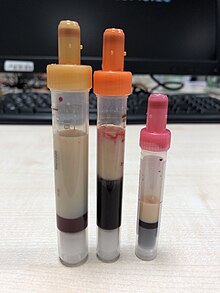
Back فرط ثلاثي غليسيريد الدم Arabic Hipertrigliceridèmia Catalan Hypertriglyceridämie German Hipertrigliceridemia Spanish Hüpertriglütserideemia Estonian Hipertriglizeridemia Basque هیپرتریگلیسریدمی Persian Hypertriglyseridemia Finnish Hypertriglycéridémie French Hipertrigliseridemia ID
| Hypertriglyceridemia | |
|---|---|
| Other names | Elevated levels of triglycerides |
 | |
| Blood samples of a young patient with extreme hypertriglyceridemia | |
| Specialty | Endocrinology |
| Complications | Heart disease, pancreatitis |
| Risk factors | Metabolic dysfunction-associated steatotic liver disease, atherosclerosis, alcoholism, metabolic syndrome |
| Differential diagnosis | Hyperlipidemia, atheroma, hypercholesterolemia, hypercalcemia |
Hypertriglyceridemia is the presence of high amounts of triglycerides in the blood. Triglycerides are the most abundant fatty molecule in most organisms. Hypertriglyceridemia occurs in various physiologic conditions and in various diseases, and high triglyceride levels are associated with atherosclerosis, even in the absence of hypercholesterolemia (high cholesterol levels) and predispose to cardiovascular disease.
Chronically elevated serum triglyceride levels are a component of metabolic syndrome and metabolic dysfunction-associated steatotic liver disease, both of which typically involve obesity and contribute significantly to cardiovascular mortality in industrialised countries as of 2021. Extreme triglyceride levels also increase the risk of acute pancreatitis.
Hypertriglyceridemia itself is usually symptomless, although high levels may be associated with skin lesions known as xanthomas.[1]
© MMXXIII Rich X Search. We shall prevail. All rights reserved. Rich X Search